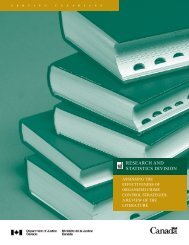National Threat Assessment 2008. Organised Crime - Politie
National Threat Assessment 2008. Organised Crime - Politie
National Threat Assessment 2008. Organised Crime - Politie
Create successful ePaper yourself
Turn your PDF publications into a flip-book with our unique Google optimized e-Paper software.
• electronic and electrical appliances (E-waste);<br />
• scrap vehicles;<br />
• mixed hazardous substances.<br />
E-waste includes all electrical and electronic waste, such as fridges, washing<br />
machines, razors and mp3 players.<br />
Scrap vehicles are vehicles that no longer meet the Dutch MOT requirements<br />
and have been deregistered with the Road Transport Agency. These scrap<br />
vehicles can often still be used in countries where vehicles are not subject<br />
to any or only a few technical requirements.<br />
The term mixed hazardous substances includes different types of substances,<br />
such as heavy metals, polychlorobiphenyl compounds (PCBs) or agricultural<br />
chemicals. Studying and describing these substances as a single generic waste<br />
stream proved to be difficult. Where possible, the research focuses on mixed<br />
hazardous waste materials.<br />
3.5.2 General context<br />
In industrialised countries environmental policy and regulations have become<br />
more and more strict in recent decades. It became more and more timeconsuming<br />
and expensive for companies to dispose of hazardous waste.<br />
As a result, increasing amounts of waste were shipped to countries with more<br />
lenient rules: developing countries and former Eastern Bloc countries. Major<br />
environmental incidents have drawn attention to the need for international<br />
waste processing agreements. For example, after the chemical disaster in 1976<br />
near the Italian town of Seveso, Seveso soil contaminated with dioxin turned<br />
up in many different places all over the world. In 1989 international agreements<br />
about controlling the cross-border shipment of hazardous substances and their<br />
disposal were laid down in the Basel Convention. These agreements were<br />
followed up in 1994 by EU Regulation 259/93 on the shipment of waste.<br />
On 12 July 2007 this ‘old’ Regulation was replaced by a new Regulation<br />
(no. 1013/2006).<br />
The current EU Regulation provides for a system of supervision and inspection<br />
of the shipment of waste to other countries. Whether a waste material may<br />
be shipped and according to which procedure, depends on:<br />
1. the nature of the waste: hazardous or non-hazardous;<br />
2. the intended processing method: useful application or disposal and;<br />
3. the destination country: a country with which a special treaty is in place<br />
or a country with which there is no special treaty.<br />
120 <strong>National</strong> <strong>Threat</strong> <strong>Assessment</strong> 2008 – <strong>Organised</strong> crime








